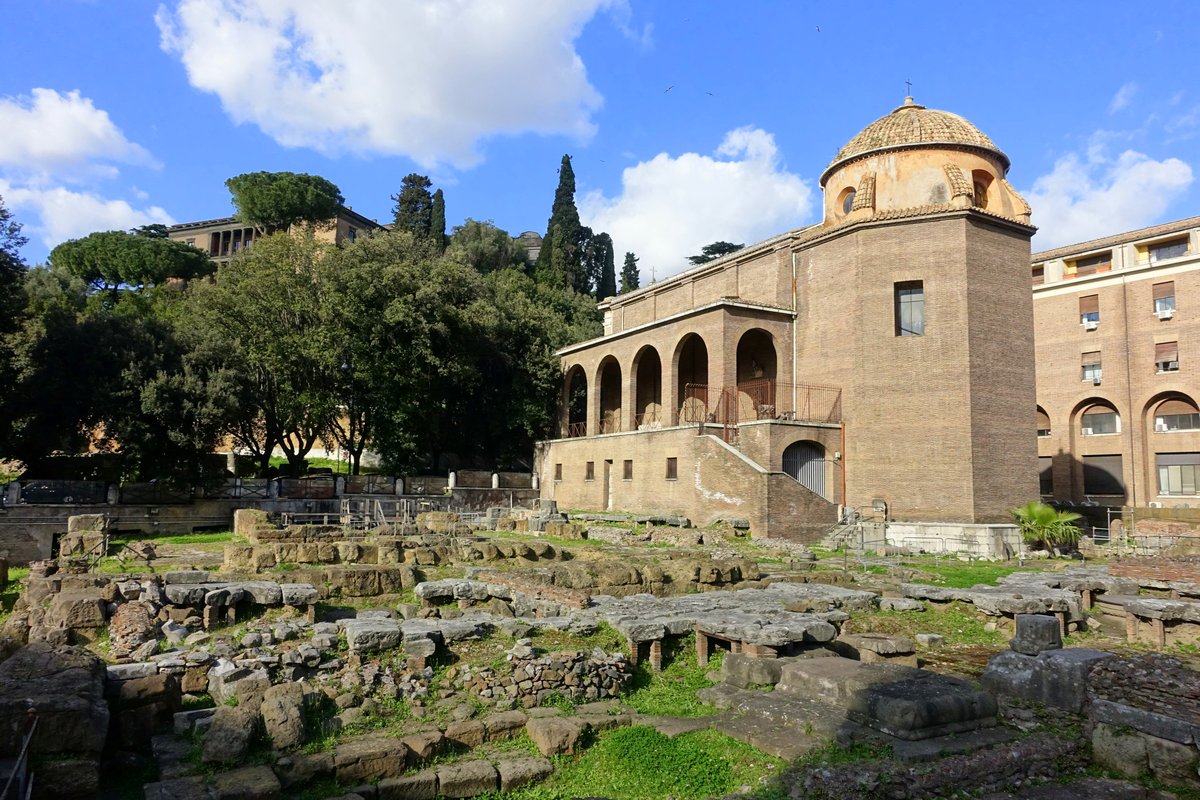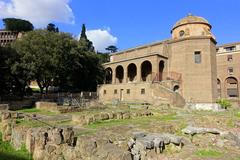
Sant’Omobono Area Rome: Visiting Hours, Tickets, and Historical Sites Guide
Date: 14/06/2025
Introduction
The Sant’Omobono Area in Rome is one of the city’s most archaeologically significant sites, offering visitors an unparalleled glimpse into Rome’s ancient origins, religious traditions, and urban development. Located near the Forum Boarium and beside the Tiber River, this site preserves a continuous record of human activity dating from the Bronze Age through the Christian era. Most famous for the remains of Rome’s oldest known temples—dedicated to Fortuna and Mater Matuta—Sant’Omobono marks a turning point in the city’s sacred architecture and reflects its transformation from clustered settlements into a cohesive urban center. Over centuries, the area evolved from a hub of archaic worship and commerce into a Christian church, embodying the city’s layered spiritual and civic history. Today, Sant’Omobono invites visitors to explore its rich archaeological narrative, whether through street-level viewing, special guided tours, or digital reconstructions. This guide offers detailed insight into the site’s history, practical visitor information, accessibility, and nearby attractions, ensuring you make the most of your visit to one of Rome’s oldest and most storied sanctuaries. (Academia.edu, Rice University Virtual Reconstruction, University of Michigan Omobono Project)
Table of Contents
- Introduction
- Site Origins and Early Development
- Religious and Cultural Significance
- Architectural Evolution and Key Discoveries
- Modern Archaeology and Research
- Visiting Information
- Visual Resources and Virtual Tours
- Frequently Asked Questions (FAQ)
- Conclusion and Recommendations
- Sources and Further Reading
Site Origins and Early Development
Sant’Omobono’s origins reach deep into the past, with archaeological evidence indicating human occupation as early as the Bronze Age. Excavations have revealed stratified layers containing pottery and settlement remains dating as far back as the 16th–12th centuries BCE (Academia.edu). The site’s monumental phase began around 580 BCE with the construction of a Tuscanic-style temple—the earliest monumental temple identified in Central Italy (Rice University Virtual Reconstruction). This temple set a precedent for sacred architecture in Rome, establishing the area as a focal point of both religious activity and urbanization.
Religious and Cultural Significance
Sant’Omobono was originally dedicated to the goddesses Fortuna (associated with luck and fertility) and Mater Matuta (goddess of dawn and childbirth), reflecting the importance of female deities in early Roman religion. Its proximity to the Forum Boarium—a bustling commercial district—meant that the sanctuary also functioned as a crossroads for merchants, traders, and foreign influences. The altar, uniquely positioned on the external axis of the temple, and the discovery of numerous votive offerings, illuminate the rituals and open nature of cultic practice at the site (Rice University Virtual Reconstruction).
Architectural Evolution and Key Discoveries
Archaic and Republican Periods
The original temple was destroyed in the late 6th century BCE and replaced around 530 BCE by a new structure that reused the earlier altar. This, too, was eventually destroyed by fire around 500 BCE. Twin temples were subsequently constructed, underscoring the area’s enduring religious importance (Rice University Virtual Reconstruction). The foundations of these temples, resting on a massive tuff platform, are still visible today.
Imperial and Christian Eras
During the Imperial period, the site underwent significant renovations, including the addition of travertine pavements and commercial shops. With the advent of Christianity, one of the temples was converted into a church—San Salvatore—later rededicated to Sant’Omobono in the Middle Ages (Academia.edu). The modern church, rebuilt in 1482, sits atop centuries of sacred foundations.
Major Archaeological Finds
Excavations have yielded hundreds of votive deposits, pottery shards, architectural fragments, and evidence of ancient sacrificial practices (Academia.edu). These artifacts are crucial for understanding Rome’s religious life during its formative centuries and can be viewed at the Capitoline Museums.
Modern Archaeology and Research
Sant’Omobono was rediscovered in 1937 during urban redevelopment. Early excavations suffered from inadequate preservation, but subsequent work by international teams has employed advanced methods such as photogrammetry and digital modeling (Rice University Virtual Reconstruction). Ongoing research continues to clarify the site’s chronology and significance, with special attention to water management given the high water table and the church above (Wanted in Rome).
Visiting Information
Hours and Accessibility
- Street-Level Viewing: The Sant’Omobono Area is visible from street level and accessible 24/7, free of charge.
- Guided Tours: Due to active excavations and preservation efforts, interior access is restricted and only possible through special guided tours, usually offered during archaeological open days or by arrangement with local authorities.
- Accessibility: The perimeter is generally accessible, but uneven pavements and lack of visitor facilities may challenge those with mobility impairments. Contact local tour providers for the latest accessibility details.
Tickets and Access
- Entry: No tickets are required for street-level viewing. Guided tours may require advance booking and sometimes a fee.
- Current Status: For up-to-date information on public openings and tour schedules, consult the Sovrintendenza Capitolina or the Turismo Roma portal.
How to Get There
- Location: Via di San Giovanni Decollato, at the foot of the Capitoline Hill, near the Forum Boarium and Tiber River.
- Public Transport: Nearest metro is Circo Massimo (Line B), with several bus lines serving the area. The site is a 10–15-minute walk from Piazza Venezia and the Roman Forum.
Tips for Visitors
- Best Times to Visit: Early morning or evening for optimal lighting and fewer crowds.
- Photography: Permitted from the perimeter. Please respect barriers and ongoing research.
- Combine Your Visit: Pair a stop at Sant’Omobono with the Capitoline Museums, Teatro di Marcello, or the Mouth of Truth for a full historic itinerary.
Visual Resources and Virtual Tours
- Virtual Reconstructions: Explore detailed 3D models and digital interpretations of the site online (Rice University Virtual Reconstruction).
- Images: Look for labeled visuals such as “Sant’Omobono archaeological site in Rome” and “Tuscanic temple ruins.”
- Maps: Interactive maps highlighting Sant’Omobono’s position relative to Rome’s major historical sites are available through academic and tourism websites.
Frequently Asked Questions (FAQ)
Q: What are the current Sant’Omobono visiting hours?
A: The site is accessible from street level at all times. Interior access is available only via occasional guided tours.
Q: Is there an entrance fee?
A: No, viewing the site from the perimeter is free. Guided tours may charge a fee.
Q: How can I join a guided tour?
A: Tours are organized during special events or by arrangement with archaeological authorities. Check the Sovrintendenza Capitolina for announcements.
Q: Is the site accessible for visitors with disabilities?
A: The viewing area is at street level and generally accessible, but uneven surfaces may pose challenges.
Q: What are the top nearby attractions?
A: Capitoline Hill and Museums, Teatro di Marcello, Santa Maria in Cosmedin (with the Mouth of Truth), and Tiber Island.
Conclusion and Recommendations
Sant’Omobono is a compelling window into the ancient roots of Rome, showcasing the city’s evolution from prehistoric settlements and archaic temples to a thriving commercial and religious center. The site’s enduring sanctity, illustrated by its transformation into a Christian church, and its strategic location at the crossroads of commerce and culture, make it a must-see for any visitor interested in the layers of Roman history. Although direct access to the ruins is limited, the site offers ample opportunities for discovery through street-level viewing, guided tours, museum visits, and digital resources. For the most enriching experience, plan your visit in coordination with special events, and complement your exploration with nearby attractions and museum exhibits. To stay updated, download the Audiala app and follow official Rome archaeological portals for the latest on tours, research, and cultural programming.
Sources and Further Reading
- Sant’Omobono: A Historic Rome Site - Visiting Hours, Tickets, and Guide to Exploring Sant’Omobono, 2025, Academia.edu
- Sant’Omobono Archaeological Site in Rome: History, Visiting Hours, Tickets & Travel Tips, 2025, Wanted in Rome & Academia.edu
- Sant’Omobono Area Rome: Visiting Hours, Tickets, History & Nearby Attractions, 2025, Ancient Rome Live & Turismo Roma
- Sant’Omobono Area in Rome: Visiting Hours, Tickets, and Historical Insights, 2025, University of Michigan Omobono Project & A Tourist in Rome
- Rice University Virtual Reconstruction of Sant’Omobono
- Sovrintendenza Capitolina Official Website
- Wikipedia: Sant’Omobono Area
- The History Blog: Earliest Temple in Rome
- Ancient Rome Live: Sacred Area of Sant’Omobono
- Rome-Roma.net: Aire Sacrée de Sant’Omobono
- Turismo Roma: Chiesa di Sant’Omobono
- A Tourist in Rome: Sacred Area of San Omobono


















































































































































































































































